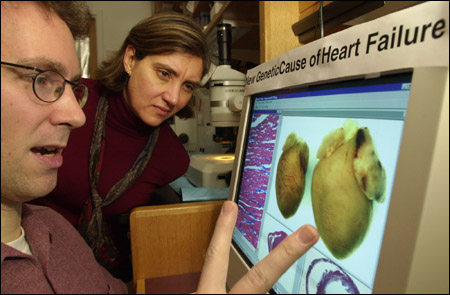Protein implicated in heart failure:
Abnormal protein interferes with calcium pump critical to heartbeat

A faulty protein that interferes with the heart muscle’s ability to relax is one cause of congestive heart failure, Harvard geneticists found in a discovery that promises more precise treatment of a disease that afflicts 4.7 million Americans.
Researchers made the discovery while studying a family in which several members develop severe heart failure by their mid-20s, often requiring heart transplants. Researchers found that family members had a faulty version of a protein called phospholamban that is an important regulator of the calcium cycle that causes heart muscle cells to contract.
Researchers had previously known the importance of the calcium cycle and of phospholamban’s critical regulatory role in it. They knew that levels of the protein, also called PLN, changed in cases of heart disease. They didn’t know, according to Harvard Medical School Professor of Genetics Christine Seidman, whether the abnormal PLN levels were a contributing factor or a result of the disease.
“We couldn’t answer the chicken-and-the-egg question,” Seidman said.
What they also didn’t know, and what Seidman and her colleagues discovered, is that in some cases faulty versions of PLN were present. Though the faulty version’s difference from normal PLN is slight, it is enough to interfere with the heart’s calcium cycle.
The calcium cycle is of critical importance in heart function because the pooling and release of calcium within a heart muscle cell triggers the contraction and relaxation that pumps blood through the body.
When the calcium is released, the muscle is stimulated to contract. PLN then regulates a protein “pump” that concentrates the calcium back into reservoirs within the cell, allowing the muscle to relax and setting up the next contraction.
The faulty form of PLN caused the protein pump to malfunction, leaving calcium free in the heart muscle cell and spurring the cell to continue contracting.
About 550,000 new cases of heart failure are diagnosed each year, according to the American Heart Association. The disease often strikes the elderly and costs the health care system $17.8 billion per year.
Heart failure can be caused by a variety of factors, including heart attack, infection, and damage from lifestyle choices such as smoking. Though there are different kinds of heart failure, the common factor among them is that they rob the organ of its capacity to beat efficiently. Blood is pumped through the body more and more slowly, leading to the characteristic weakness and sometimes death that accompany the disease.
Seidman, along with her husband, Bugher Foundation Professor of Genetics Jonathan Seidman, research fellows Joachim Schmitt and Mitsuhiro Kamisago, and collaborators at the University of Toronto and the University of Cincinnati, conducted the study, which was published in the journal Science Feb. 28.
Researchers discovered a small mutation in the gene responsible for PLN in members of the family they studied. Because affected family members had no other cause for heart failure which occurred early in adulthood, the researchers could deduce that defective PLN was the fundamental cause. They proved it by introducing the mutation into a mouse, which then developed the heart disease. By identifying a specific gene responsible for the faulty form of PLN, Seidman said researchers proved that the faulty protein is a cause, rather than a result, of heart failure.
Though very few people have that type of inherited heart failure, Seidman said the study has broader implications as well. It indicates that other abnormal proteins that also disrupt the calcium cycle may cause other forms of the disease.
That finding, she said, opens up many avenues of inquiry and shows that treatments can focus on specific proteins. Current treatments are far more general, focusing on reducing fluid buildup caused by the weakening heart’s inability to pump efficiently. More targeted treatments could be tailored to a patient’s particular condition, Seidman said, and could be layered on top of one another in the case of multiple factors.
“Heart failure is a complex syndrome and there are many different pathways by which the heart fails,” Seidman said. “A dysfunctional, poorly contracting heart is now always looked at as the same thing.”
Seidman and colleagues are looking at the next steps in unraveling the mystery about PLN. They’re looking at how a disruption in the calcium cycle kills heart cells and what would happen if they try to regulate the PLN protein.
“We can regulate the regulator. We want to know what the consequences are of manipulating phospholamban,” Seidman said.




